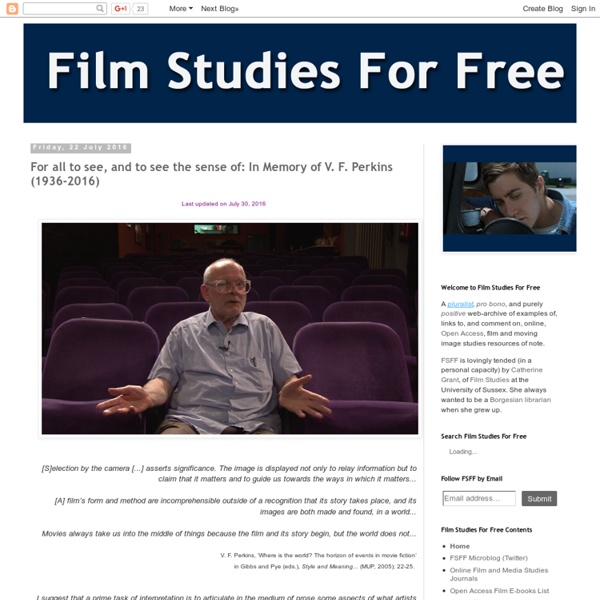



Images: A Journal of Film and Popular Culture | The Permanent Seminar on Histories of Film Theories | Cineaste Magazine - Home Observations on film art The Adventures of Prince Achmed. Kristin (with some help from David) here: David and I have been offering this greatest-of-90-years-ago series almost as long as this blog has existed. For earlier annual entries, see 1917, 1918, 1919, 1920, 1921, 1922, 1923, 1924, and 1925. I approached 1926 with the assumption that it would present a crowded field of masterpieces; surely it would be difficult to choose ten best films. Still, the Soviet directors were going full-tilt by this time and contribute three of the ten films on this year’s list. The Russians are coming Vsevolod Pudovkin’s Mother was a full-fledged contribution to the new Montage movement in the Soviet Union. Along with Potemkin, Mother was one of the key founding films of the Montage movement. As the Mother sits beside her husband’s dead body, her son, a participant in the 1905 failed revolution, comes in. Mother was released on DVD by Image Entertainment in 1999, but it seems to be very rare. Petit mais grand Lloyd and Lubitsch
Canada's leading film studies journal Screenplay Basics - Scripped - StumbleUpon A Scripped Compendium by Johnathan Carr Traditional storytelling recounts past events, whereas screenwriting is locked in the present - thus you may not deviate from PRESENT TENSE. You may also be tempted to describe every inch of the world you're creating - don't! At the beginning of a feature film script, often but not always, the first line will be: FADE IN. While you can write a longer ACTION paragraph, think about keeping it under five lines at a time. In the ACTION line, be sure to capitalize SOUND EFFECTS, CAMERA DIRECTION and the first appearance of a speaking CHARACTER. Use a PARENTHETICAL to note an action the speaker is performing while speaking or if you want to indicate whom the speaker is addressing such as addressing a new character in mid-DIALOGUE. Off camera (O.C.) and off screen (O.S.) are identical, which one you use is really a personal preference. Describe specific SHOTS only when necessary, not every little bit of CAMERA DIRECTION need be mentioned. Think subtext.
Film Reference 15 Film Production Credits Explained Ever wonder what all those strange credits are when they roll by at the end of a film? I used to, until I moved to LA, where I started meeting Best Boys and Dolly Grips with their kids when I took my son to the playground—yes, Hollywood, where you meet Gaffers and Armourers at your average Saturday night house party. So I started asking questions, and here's what I've learned: 1. Boom Operator No, this job has nothing to do with explosives or pyrotechnics. 2. Now this job does deal with explosives, of a sort. 3. Though the gaffer manages the entire electrical department, all the guys who run cables and hang lights, his main responsibility is mounting and positioning lights and lighting rigs. 4. Grips are sort of like worker bees. 5. This guy runs the Grips dept and assists the Gaffer. 6. This guy has nothing at all to do with a wedding, unless we're talking something like Wedding Crashers . 7. A dolly grip operates the movie camera dolly. 8. 9. 10. This guy oversees the painting dept. 11.
Bad Lit: The Journal of Underground Film Metaphilm - See through cinema. Cineflyer 100 Ideas That Changed Film by Maria Popova How the seventh art went from magic lanterns to state-of-the-art computer-generated imagery in 100 years. When a small handful of enthusiasts gathered at the first cinema show at the Grand Cafe in Paris on December 27, 1895, to celebrate early experimental film, they didn’t know that over the next century, their fringe fascination would carve its place in history as the “seventh art.” But how, exactly, did that happen? In 100 Ideas that Changed Film, Oxford Times film reviewer David Parkinson and publisher Laurence King — who brought us 100 Ideas That Changed Graphic Design and the epic Saul Bass monograph — offer a concise and intelligent chronicle of the most influential developments since the dawn of cinema. Parkinson promises in the introduction: What follows is as much a chronology of business opportunism and technical pragmatism, as a celebration of artistry, social commitment, and showmanship. Idea # 1: MAGIC LANTERNS Idea # 20: SERIALS Idea # 28: GENRE Idea # 54: SHORTS
Reality Checks: Four Major Documentary Filmmakers Have Died This Year. These Are Their Legacies.|Filmmakers,Film Industry, Film Festivals, Awards & Movie Reviews | Indiewire By Anthony Kaufman | Indiewire May 29, 2014 at 10:51AM It always sucks when someone dies. But in the small world of documentary filmmaking, where the directors are a close-knit, dogged group, the loss of a fellow intrepid traveler is like losing a member of your extended family. Top L to Bottom R: Michael Glawogger, Malik Bendjelloul, Ed Pincus and Peter Wintonick It always sucks when someone dies. But in the small world of documentary filmmaking, where the directors are a close-knit, dogged group, traveling to the same events and sharing the same few resources to tell their often personal or passionate stories, the loss of a fellow intrepid traveler cuts deep. The loss of just one of these filmmakers provides plenty to mourn, but the death of four beloved directors within a short time is cause for serious pause. What’s more, their diversity of styles and subject matters attest to the breadth and scope of current documentary film. Michael Glawogger's "Whore's Glory."